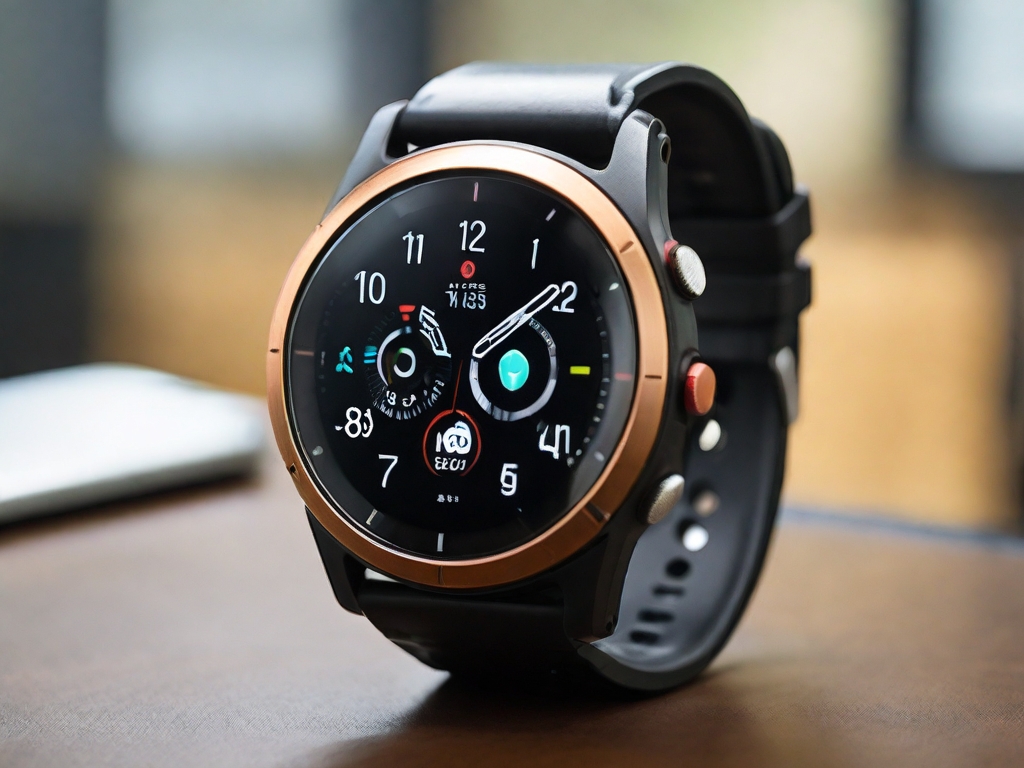Table of Contents
Discover the impact and future trends of wearable technology in virtual fitness, including the evolution of wearable devices, benefits for users, popular devices in the market, and how wearables can enhance employee safety.

The Evolution of Wearable Technology in Virtual Fitness
Wearable technology (i.e., smartwatches) has significantly transformed the way keep fit people monitor their fitness goals by providing real-time data and personalised insights. These devices have changed the face of fitness and health monitoring, offering users the ability to track their progress and make informed decisions about their exercise routines. The convenience and accessibility of wearable devices have empowered users to take charge of their fitness journeys with valuable information at their fingertips.
For example, fitness trackers like the Fitbit Charge 4 not only monitor daily activities but also provide data on heart rate, sleep patterns, and calories burned, allowing users to gain a comprehensive understanding of their overall health.
Moreover, wearable technology has played a pivotal role in fostering accountability and motivation among individuals engaging in virtual fitness programmes. By offering real-time feedback on performance metrics and progress tracking, wearables serve as personal trainers on the go, guiding users towards their fitness goals. For example, smartwatches like the Apple Watch Series 7 offer features such as workout tracking, heart rate monitoring, and goal setting, creating a holistic fitness experience for users. Despite the challenges faced by wearables in accurately estimating metrics during exercise, the integration of these devices into virtual fitness platforms underscores their significance in enhancing user engagement and satisfaction.
Benefits of Wearable Tech in Virtual Fitness
Wearable technology has significantly transformed the way people monitor their fitness goals in virtual fitness programmes. These devices offer a wide range of benefits, including enhanced monitoring and feedback to users, which enables them to track their progress effectively. For example, fitness trackers like the Fitbit Charge 4 are equipped with advanced sensors that accurately monitor metrics such as heart rate, steps taken, and calories burned, providing users with detailed insights into their daily activities and overall fitness levels.
Moreover, the improved training efficiency facilitated by wearable devices is a key advantage in virtual fitness programmes. These devices help individuals optimise their workouts by providing real-time data on their performance, allowing them to adjust their exercise intensity and duration for better results. For instance, smartwatches such as the Apple Watch Series 7 offer features like workout tracking, guided breathing exercises, and personalised coaching, making virtual fitness more interactive and tailored to individual needs.
Additionally, popular wearable devices not only track users’ fitness metrics but also provide tools for goal setting, progress tracking, and various advanced functionalities that boost motivation and engagement. By setting specific fitness goals on their devices and monitoring their progress over time, users can stay accountable and motivated to achieve their desired outcomes. These features create a gamified experience that encourages users to push their limits and strive for continuous improvement in their fitness journeys.
 Popular Wearable Devices in Virtual Fitness
Popular Wearable Devices in Virtual Fitness
When delving into the world of virtual fitness, it becomes evident that certain wearable devices have emerged as frontrunners in aiding individuals in their fitness journeys. One such device is the Fitbit Charge 4, revered for its precision in tracking various fitness metrics, making it a popular choice among users seeking accurate real-time data to monitor their progress. The Fitbit Charge 4 not only tracks basic metrics like steps taken and calories burned but also delves into more advanced features such as heart rate monitoring and sleep tracking, offering a comprehensive overview of one’s health and fitness status.
Moreover, smartwatches like the Apple Watch Series 7 are dominating the virtual fitness landscape due to their multifunctional capabilities and seamless integration with fitness apps and platforms. The Apple Watch Series 7 goes beyond just tracking fitness metrics; it provides users with personalised insights, workout suggestions, and even the ability to participate in virtual workout classes, enhancing the overall fitness experience. By leveraging the advanced features of such smartwatches, individuals can engage more actively in their virtual fitness routines, set challenging goals, and stay connected to a broader fitness community, fostering a sense of motivation and accountability.
Future Trends in Virtual Fitness Technology
The global wearable device market is forecasted to reach $62.82 billion by 2025, showcasing the escalating consumer interest in wearable fitness technology. This surge in market value underscores the growing significance of wearables in the fitness industry, paving the way for innovative advancements to meet the demands of tech-savvy fitness enthusiasts. For instance, the integration of advanced biometric sensors in wearable devices allows for more accurate and comprehensive fitness tracking, providing users with detailed insights into their health and performance levels.
Here is something interesting: Moreover, the incorporation of augmented reality/virtual reality (AR/VR) technologies and artificial intelligence/machine learning (AI/ML) algorithms in wearable fitness devices is propelling the industry towards a more interactive and personalised fitness experience. These cutting-edge technologies not only enhance user engagement but also offer tailored workout routines, real-time feedback, and immersive fitness challenges. For example, AR/VR features can transport users to virtual environments, making workouts more engaging and motivating, while AI algorithms can analyse data to provide customised training recommendations based on individual fitness goals and progress.
As wearables advance further, they are anticipated to seamlessly blend into everyday life through Internet of Things (IoT) capabilities. This integration aims to create a holistic ecosystem where wearable devices work harmoniously with other smart devices, such as home appliances and personal gadgets, to streamline fitness tracking, goal setting, and overall well-being management. By leveraging IoT, wearables are poised to redefine how individuals approach fitness, making it more accessible, interconnected, and integrated into their daily routines.
Wearable Technology Enhancing Employee Safety
Beyond personal fitness, wearable technology also plays a significant role in enhancing employee safety and productivity in various industries [2]. These devices offer benefits such as emergency response capabilities, accurate location tracking, and improved safety measures in the workplace, contributing to a safer and more efficient working environment. By leveraging wearable technology, employers can ensure the well-being and productivity of their workforce, highlighting the broader applications and advantages of wearables beyond fitness tracking.
Moreover, wearable technology in industrial settings provides employees with real-time alerts and notifications regarding potential hazards or emergencies, allowing for proactive responses to mitigate risks and ensure a safer work environment. For example, devices like the Lively Mobile Plus offer features such as fall detection and emergency notifications, enabling swift assistance in case of accidents or injuries. This seamless integration of wearable devices not only enhances safety protocols but also fosters a culture of care and support within organisations, promoting overall employee well-being.
Furthermore, the integration of wearable technology in industries extends to sectors like construction, manufacturing, and healthcare, where worker safety is paramount. Wearable devices equipped with GPS tracking can monitor employees’ locations, particularly in high-risk environments, ensuring their safety and enabling timely interventions if needed. For instance, in the construction industry, wearables like smart helmets with built-in sensors can detect potential head injuries and alert supervisors, underscoring how technology can significantly improve workplace safety standards and practices. The adoption of wearable technology not only enhances employee safety but also boosts operational efficiency and risk management strategies, positioning it as a vital tool for ensuring a secure and productive work environment.

Wearable technology continues to reshape the landscape of virtual fitness by providing users with powerful tools to optimise their fitness routines effectively. The transformative role of wearables in virtual fitness underscores the importance of integrating technology to promote a healthier and more active lifestyle, empowering individuals to achieve their fitness goals and lead fulfilling lives.
As wearable technology evolves, we can expect to see even greater advancements in virtual fitness. For example, the integration of augmented reality (AR) and virtual reality (VR) technologies in wearables is set to revolutionise how individuals engage with fitness activities. These immersive experiences will not only make workouts more enjoyable but also more effective by increasing user engagement and motivation.
Moreover, the future of wearable devices in virtual fitness is likely to focus on personalisation and real-time feedback. For instance, advanced biometric sensors in wearables will enable users to receive accurate and detailed insights into their performance during workouts, helping them make informed decisions to improve their overall fitness levels. This tailored approach to fitness tracking will empower individuals to set and achieve specific goals, ultimately leading to better results and a more satisfying fitness journey.
If you need any further information or assistance with this article, don’t hesitate to Contact Us




















